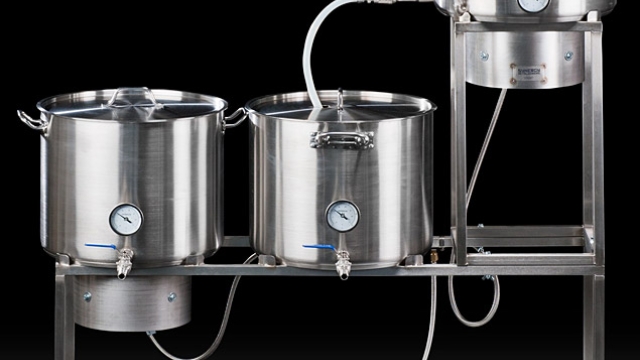Craft beer has taken the world by storm, inspiring a revolution in taste and creativity. Behind every pint of delicious craft brew, there is a fascinating world of brewery equipment that helps bring this flavorful revolution to life. From towering fermenters to intricate brewing systems, brewery equipment forms the backbone of any successful craft brewery.
So, what exactly is brewery equipment? In simplest terms, it refers to the machinery, tools, and vessels used in the production and operation of a brewery. From the moment the ingredients are combined to create the perfect mash, to the final packaging and distribution of the finished product, brewery equipment plays an integral role every step of the way.
A comprehensive brewery equipment guide is essential for those embarking on their own craft beer journey. Whether you’re a seasoned brewer looking to expand your operation or a passionate beer enthusiast dreaming of starting your own microbrewery, understanding the different types of equipment is crucial. So let’s dive deep into the world of brewery equipment and uncover the mysteries behind each essential component. Get ready to unleash the craft beer revolution!
Understanding Brewery Equipment Basics
Brewery equipment is an essential component of the craft beer revolution. It plays a crucial role in the beer-making process, ensuring the quality and consistency of the final product. In this guide, we will explore the fundamentals of brewery equipment and its significance in the brewing industry.
Mash Tun and Brew Kettle: The mash tun and brew kettle are two key pieces of brewery equipment used in the initial stages of the brewing process. The mash tun is where the malted grains are mixed with hot water, allowing the enzymes to convert starches into fermentable sugars. The brew kettle, on the other hand, is where the liquid extracted from the mash is boiled with hops, creating a flavorful wort.
Beer Brewing EquipmentFermentation Vessels: After the wort is prepared, it needs to undergo fermentation to transform the sugars into alcohol and carbon dioxide. Fermentation vessels, such as fermenters or conical tanks, provide the ideal environment for yeast to work its magic. These vessels are designed to control temperature, pressure, and allow for the removal of unwanted byproducts, resulting in the desired flavors and characteristics of the beer.
Bright Tanks and Packaging Equipment: Once fermentation is complete, the beer enters the final stages of the brewing process. Bright tanks are used for conditioning the beer, allowing any remaining yeast or sediment to settle before packaging. Packaging equipment, including canning or bottling machines, ensures the beer is sealed and preserved, ready to be enjoyed by beer enthusiasts everywhere.
Understanding the basics of brewery equipment is essential for aspiring brewers and beer enthusiasts. From the mash tun to the packaging equipment, each piece plays a vital role in creating the perfect pint. So next time you savor a craft beer, take a moment to appreciate the craftsmanship and precision that goes into brewing, made possible by these incredible brewing tools.
Essential Brewery Equipment for Craft Beer Production
Craft beer production requires specialized brewery equipment to ensure the quality and consistency of the beer. In this section, we will explore the essential equipment that every craft brewery needs.
Mash Tun: The mash tun is an essential piece of equipment used during the mashing process. It is typically a large vessel where the milled grains, known as malt, are mixed with hot water to extract sugars. The mash tun allows for the controlled conversion of starches to fermentable sugars, which are vital for yeast fermentation.
Fermentation Vessels: Fermentation vessels are where the magic happens. These vessels, often made of stainless steel or glass, provide a controlled environment for yeast to convert sugars into alcohol and carbon dioxide. They come in various shapes and sizes, such as uni-tanks or conical fermenters, and are equipped with airlocks to allow the release of carbon dioxide while preventing oxygen from entering.
Bright Tanks: After the initial fermentation, the beer is transferred to bright tanks for conditioning and carbonation. These tanks are designed to clarify the beer further and allow any remaining sediment to settle. They are often equipped with carbonation stones or spunding valves to add carbon dioxide and achieve the desired level of carbonation.
Craft breweries may also invest in additional equipment such as boilers, chillers, filtration systems, or bottling lines to support their beer production process. While these pieces of equipment are not mandatory, they can streamline operations and ensure consistent quality.
By having the right brewery equipment, craft brewers can unleash their creativity and produce high-quality beers that cater to the ever-growing demand for unique and flavorful brews.
Remember, the equipment mentioned here is just a starting point, and depending on the scale and ambition of your craft brewery, you may need to invest in additional or more advanced equipment.
Choosing the Right Brewery Equipment for Your Brew Pub

When it comes to setting up a successful brew pub, choosing the right brewery equipment is of utmost importance. The equipment you select will directly impact the quality and efficiency of your brewing process, ultimately influencing the taste and consistency of your craft beer. In this guide, we will walk you through the key considerations to keep in mind when selecting brewery equipment for your brew pub.
First and foremost, understanding the specific needs and requirements of your brew pub is essential. Factors such as the size of your operation, anticipated production volume, and the types of beer you aim to brew will play a significant role in determining the appropriate brewery equipment. Whether you are a small-scale brew pub focusing on a few signature craft beers or a larger establishment with a diverse range of offerings, customizing your equipment to suit your specific needs will ensure optimal results.
Another crucial aspect to consider is the level of automation you desire in your brewing process. From manual systems to fully automated setups, the level of automation will impact the efficiency, consistency, and control over your brewing operations. Depending on your budget, resources, and personal brewing preferences, you can choose equipment that ranges from manual mash tuns and kettle systems to advanced computer-controlled brewhouses.
Lastly, it’s important to consider the maintenance and support that will come with your chosen brewery equipment. Brewing equipment requires regular maintenance and occasional repairs, so ensuring that you have easy access to spare parts and reliable technical support is vital. Opting for equipment from reputable manufacturers and suppliers who offer comprehensive after-sales service can save you valuable time, money, and potential headaches in the long run.
In conclusion, selecting the right brewery equipment for your brew pub is a crucial step towards unleashing the craft beer revolution you envision. By understanding your specific needs, considering the level of automation, and ensuring access to maintenance and support, you can set yourself up for success in brewing exceptional craft beer consistently. So, take the time to research, consult with experts, and invest wisely in brewery equipment that aligns with your goals and aspirations.



